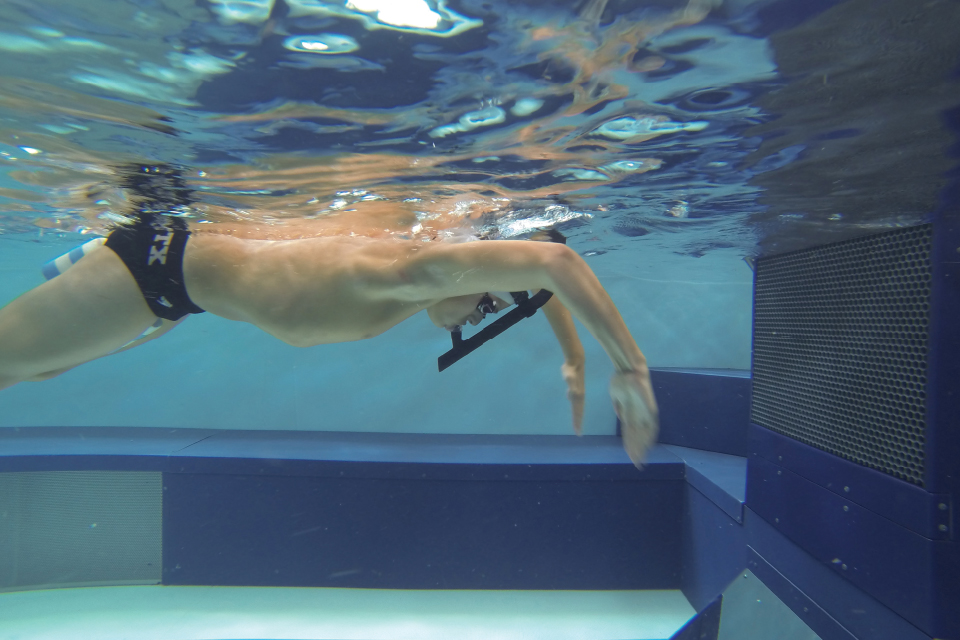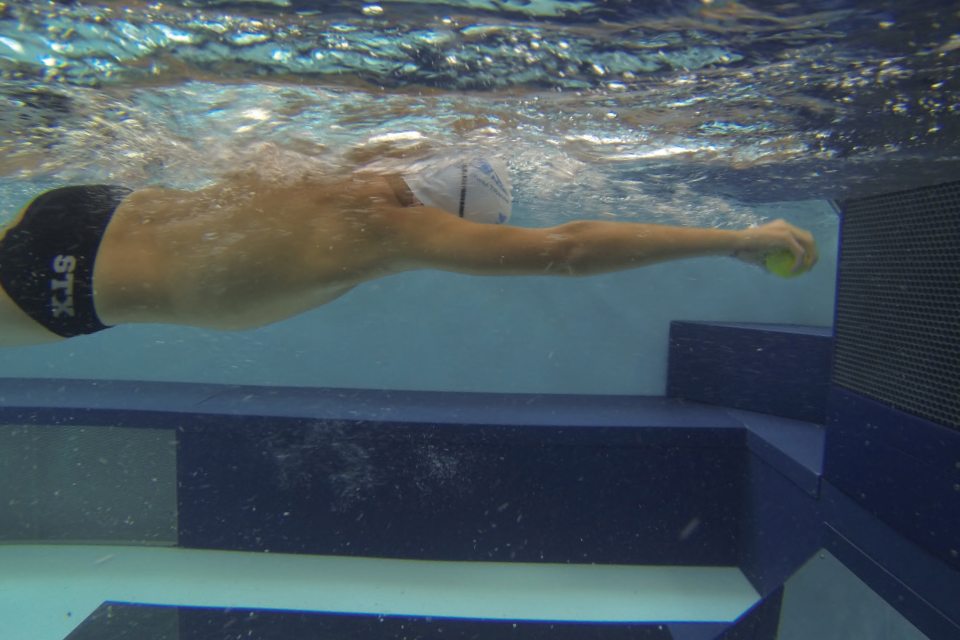Learning to Feel the Water in Swimming

I like to think that feel for the water is like rhythm for a dancer. Though some people seem to be naturally gifted, a feel for the water is certainly a skill for swimmers to develop. Develop is the key; it takes time and practice, and forcing the skill can hurt more than help.
During Olympic swimming coverage, commentator Rowdy Gaines referred to Michael Phelps and Missy Franklin as “holding the water” or having “great feel for the water.” What exactly did he mean? Gaines was referring to a swimmer’s ability to treat the water like a solid—placing the hand and forearm on it and moving the body past the hand. The swimmer is holding onto the water.
Successful swimmers typically have a very high, early catch and instead of the “blade” of their paddle (the hand and forearm) slipping past the torso, they hold that catch position. To move past their arm, swimmers use core rotation and a strong kick. This dynamic is why I like to refer to the catch as the “anchor” in the stroke. Elite swimmers’ hands actually enter and exit in almost the same spot. Again, think of the pulling arm as “anchored” when it is in the catch position and with momentum from the rotation and kick (and in some cases, such as freestyle and backstroke, the recovering arm) creating movement past that anchor.
I generally coach all of my swimmers on improving their catch or anchor and in doing so, I always talk about developing a better feel for the water. Feel involves knowing what direction your blade is facing, the pitch changes you make, and how much pressure is needed on the water. I asked Longhorn Aquatics coach and 2014 Master’s Coach of the Year Whitney Hedgepeth if she believed “feel” can be developed and she definitely does. “The older you get, the harder it is to find the feel for the water,” said Hedgepeth. “Fear of the water, body awareness, and body mass will all play a role.”
To help you enjoy your time in the water and keep swimming smart, here are some drills for developing feel for the water.
Sculling
Sculling is a drill that helps strengthen the important muscles in the hand and forearm as well as develop feel for the water. It’s important to have proper positioning when sculling. Think of your forearm as a blade of an oar. Consider that when paddling a kayak, canoe, or SUP, the blade is pitched to face opposite the direction the craft is headed. Keeping that in mind, position your blade to face the wall you just pushed off from—opposite of where you are headed. Here are two different sculling drills to practice.
Strapless Paddles
No, I am not encouraging you to buy another piece of equipment; use the paddles you currently own. Just take the straps off.
After you have learned how to scull properly, use paddles without straps to provide sensory feedback as to whether constant pressure is being kept on the water. Put the paddle flat on your hand (no wrapping your fingers around the top or sides—the paddle stays on solely because of adequate pressure and maintaining the correct pitch of your blade). Yes, the paddles will fall off but that sensory feedback will help cue in on what you did wrong. I love to have my breaststrokers get good enough that they can swim full breaststroke without ever losing a paddle.
Windshield Wiper Scull (demonstrated in main image)
Lie facedown in the water, flat and balanced. Imagine lying over the roof of a car and your arms becoming the windshield wipers. Use a pull buoy or a very light flutter kick, ideally while wearing a front-mounted snorkel. Keeping the elbows ahead of the ears, bend the elbows so that fingertips are pointing to the bottom of the pool. Pitch your blade slightly inward on the sweep in and slightly outward on the sweep out, tracing the shape of very thin infinity signs. Remember: The goal is to keep that blade facing backwards as much as possible, so be careful not to turn too much. Don’t just turn the wrist; your blade is one piece—no hinges at the wrist.
.jpg)
Reverse Tuck Scull
This is a challenging drill that I use more for strengthening than developing feel. Begin by facing away from the direction you want to go. Sit up in the water in a very tight tuck with toes and shins at the surface, tops of the quads in contact with the torso. With elbows to the side, face your blades in the direction you are looking (opposite to where you are heading) and put pressure on the water in small quick movements, as if scrubbing a window. The faster you “scrub,” the faster you move. Don’t be surprised by a burning sensation in the forearms and abs; you’ll feel it very quickly if you’re sitting up correctly.

Tennis Ball Swimming
I use this drill to learn to appreciate how valuable my hand and forearm are in efficient swimming. Take away the surface area of the hand, and you’ll be amazed at how quickly it’s missed. Swimming with fists is a common drill, but I like to take it one step further by putting a tennis ball or whiffle ball in the hand; those trying to value the blade will be extra diligent about recognizing the feel of the water on the forearm and setting up a better catch. Another good sensory addition to this drill is to swim a certain number of cycles with the balls and then drop them mid-cycle. You’ll be amazed at how much you can feel on the palm of your hand and how valuable it is to efficient swimming.






